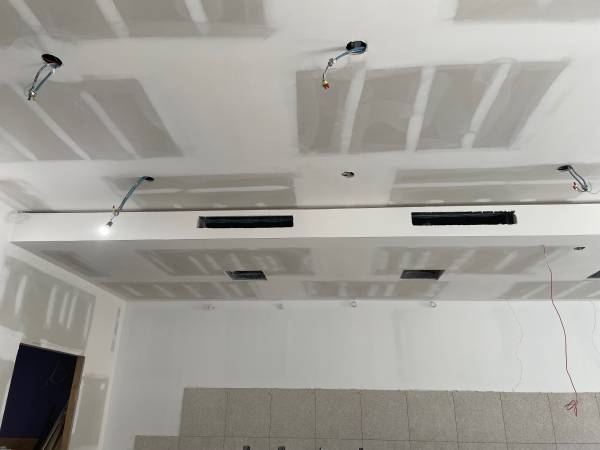Table of Contents
Preparation of the workspace for drywall taping
To begin any drywall taping project, it is imperative to establish a well-prepared workspace. Clear the area of any obstacles or debris that could hinder your progress or compromise the quality of the final result. A clean and organized workspace not only facilitates a smoother workflow but also ensures a safer environment to carry out the task effectively. Make sure to have adequate lighting in place to accurately assess the surface and achieve precise taping and mudding.
Next, gather all the necessary tools and materials needed for the project. This includes drywall tape, joint compound, taping knives, sandpaper, and a sturdy ladder. Having everything within reach before commencing work saves time and prevents distractions during the taping process. Arrange your materials in a systematic manner to enhance efficiency and minimize delays. By investing time in preparing your workspace and assembling the required tools, you set a solid foundation for a successful drywall taping job.
Selection of the right tools for drywall taping
Having the appropriate tools for your drywall taping project is crucial for achieving a smooth and professional finish. A few essential tools to have on hand include a taping knife, mud pan, drywall tape, joint compound, sandpaper, and a utility knife. It is important to invest in high-quality tools to ensure precision and efficiency during the taping process.
In addition to these basic tools, consider using a corner tool for seamless corners, a drywall rasp for shaping edges, and a sanding pole for reaching high areas. Having a variety of tools at your disposal will help you tackle different aspects of the taping job with ease and accuracy. Remember, using the right tools not only simplifies the process but also leads to a professional-looking finish that will enhance the overall appearance of your drywall project.
Properly measuring and cutting drywall tape
When it comes to working with drywall tape, precision is key. Before cutting the tape, it is crucial to accurately measure the length needed for the joint you are working on. Take a measuring tape and carefully determine the exact distance to avoid any excess or shortage of tape, which could lead to uneven joints or visible imperfections once the project is complete.
Once you have measured the required length, use a sharp utility knife or scissors to make a clean and straight cut. It is essential to cut the tape smoothly to ensure a seamless finish. Avoid using dull tools or tearing the tape, as this can result in jagged edges that will be challenging to conceal once the joint compound is applied. Take your time to execute a precise cut, as this step lays the foundation for a professional-looking drywall finish.
Applying the first coat of joint compound
Once the drywall tape is in place, it is time to apply the first coat of joint compound. This initial layer is crucial in establishing a strong foundation for the subsequent coats. Using a taping knife, scoop out a generous amount of joint compound and apply it over the taped seams in smooth, even strokes. Make sure to cover the tape completely, pressing down gently to ensure good adhesion. The goal is to fill in any gaps and create a seamless transition between the drywall panels.
After applying the first coat, take a step back and inspect your work. Look for any areas where the joint compound may be too thick or too thin, and adjust as needed. Remember that a smooth application now will make the rest of the taping and mudding process much easier. Allow the first coat to dry completely before moving on to the next step. Patience is key in achieving a professional-quality finish, so resist the temptation to rush the drying process.
Embedding the tape smoothly
To embed the drywall tape smoothly, start by applying a thin layer of joint compound over the seam. Ensure that the layer is even and covers the tape completely, pressing it firmly into place. Use a taping knife to gently smooth out any air bubbles or wrinkles in the tape, being careful not to remove too much compound. This step is crucial in creating a strong and seamless joint between the drywall sheets.
Next, carefully add another layer of joint compound over the embedded tape. Use a wider taping knife to feather out the edges, blending the compound into the surrounding surface. Keep the pressure consistent as you spread the compound to maintain a uniform thickness. Remember, the key to embedding the tape smoothly is to work gradually, building up the layers of compound while ensuring a flush and flat finish.
Using a taping knife effectively for drywall taping
Ensuring that you have the right tools for the job is essential when it comes to effectively using a taping knife in the drywall taping process. When selecting a taping knife, opt for one that is sturdy and well-balanced to provide you with optimal control and precision during application. A taping knife with a flexible blade will allow you to smoothly glide the joint compound while ensuring a seamless finish.
When using a taping knife, it is crucial to apply even pressure along the length of the blade to avoid creating ridges or bumps in the joint compound. Hold the knife at a slight angle to the surface and use long, smooth strokes to spread the compound evenly over the taped seams. Be mindful of any excess compound that may build up on the sides of the knife, as this can result in an uneven application. By mastering the technique of using a taping knife effectively, you can achieve professional-grade results in your drywall taping project.
Feathering out the joint compound
Achieving a smooth and seamless finish when applying joint compound involves the crucial step of feathering out the compound. This process is essential for blending the edges of the compound with the surrounding wall surface, creating a seamless transition that hides the seams and imperfections. To feather out the joint compound effectively, use a wide taping knife and apply even pressure as you spread the compound beyond the edges of the taped area. The goal is to gradually thin out the compound towards the edges to create a smooth transition without visible lines or ridges.
Proper feathering out of the joint compound requires precision and patience. Work methodically, applying a thin layer of compound and then gradually spreading it outwards in all directions. Use long, smooth strokes to create a gradual taper from the center of the taped area towards the edges. Avoid applying too much pressure or overworking the compound, as this can result in uneven surfaces and visible lines that will be difficult to conceal in later stages of the finishing process.
Sanding between coats during drywall taping
Once the first coat of joint compound has dried thoroughly, it is essential to sand the surface before applying subsequent coats. Sanding between coats ensures a smooth and even finish by removing any imperfections or rough spots left behind during the initial application. This step is crucial in achieving a professional-looking result that is free of bumps or ridges.
Using a fine-grit sandpaper, gently sand the dried joint compound to create a flat and level surface. Be sure to feather out the edges of the compound to seamlessly blend it with the surrounding areas. Take care not to oversand, as this can result in uneven patches or damage to the drywall. After sanding, wipe down the area with a clean, damp cloth to remove any dust or debris before applying the next coat of joint compound. Remember, proper sanding between coats is key to achieving a flawless finish in your drywall taping project.
Applying subsequent coats of joint compound
After allowing the previous coat of joint compound to fully dry, it is time to apply the subsequent coat. Ensure that the area is clean and free of any debris before proceeding. Using a clean taping knife, scoop out a small amount of joint compound and apply it over the taped seams. Work in smooth, even strokes to achieve a uniform coverage. Keep in mind to feather out the edges of the compound to blend it seamlessly with the surrounding wall surface for a professional finish.
While applying the subsequent coat, focus on building up the thickness gradually to fill in any gaps or indentations left from the previous layer. This will help in achieving a smooth and level surface once the taping process is complete. Take your time to work meticulously, ensuring that the joint compound is applied evenly across the taped seams. Remember, each coat is crucial in building up the strength and durability of the joint, so do not rush through this step.
Ensuring smooth and even coverage
To achieve a professional finish when applying joint compound for drywall taping , it is essential to ensure smooth and even coverage across the surface of the drywall. Applying an even layer of joint compound helps in creating a seamless transition between the taped areas and the rest of the wall. This can be achieved by using a taping knife to spread the compound evenly over the taped joints, working from the center outwards to feather the edges for a smooth blend.
Careful attention should be paid to applying the joint compound with consistent pressure and thickness to avoid creating uneven surfaces that may be challenging to sand down later. By maintaining a steady hand and utilizing proper technique, such as using long, smooth strokes with the taping knife, you can ensure that the joint compound is evenly distributed and covers the taped seams effectively. This meticulous approach will result in a uniform surface that is ready for further coats of compound and eventual finishing touches for a professional-looking result.
Checking for imperfections
After applying the joint compound and embedding the drywall tape, inspect the surface of your drywall taping job for any imperfections that may compromise the final finish. Imperfections such as bumps, ridges, or air bubbles can detract from the overall smoothness and aesthetic appeal of the wall. Carefully run your hand over the surface to feel for any irregularities that may need to be addressed before proceeding to the next coat of joint compound.
In addition to tactile inspection, visually scrutinize the taped joints for any visible imperfections. Look for gaps between the tape and the drywall, as well as any areas where the tape may be lifting or wrinkling. These issues can lead to cracks or bumps in the finished surface if left unattended. Addressing these imperfections at this stage will ensure a flawless final result once the finishing touches are applied.
Addressing any bubbles or wrinkles in the tape
To address any bubbles or wrinkles in the tape during drywall taping , it is crucial to address them promptly to ensure a seamless finish. Start by making a small incision at the center of the bubble using a sharp utility knife. Gently press down on the edges of the bubble to release any trapped air or excess joint compound. Smooth out the tape carefully, ensuring it is properly embedded in the joint compound.
Once the bubble or wrinkle is flattened, apply a thin layer of joint compound over the area to secure the tape in place. Use a taping knife to feather out the edges of the patch, blending it with the surrounding wall. Allow the patch to dry completely before sanding it down lightly to create a smooth surface for the next coat of joint compound. Remember to inspect the area closely to ensure no imperfections remain before proceeding with the finishing touches for a professional result.
Finishing touches for a seamless drywall taping job
After applying the final coats of joint compound and allowing them to dry thoroughly, it is crucial to inspect the surface for any imperfections or rough areas. Using a sanding block with fine-grit sandpaper, gently sand the entire surface to achieve a smooth and even finish. Take care not to oversand and create uneven patches that will be visible once painted.
Once sanding is complete, wipe down the walls with a damp cloth to remove any dust or debris that could affect the final appearance. Inspect the surface again to ensure all imperfections have been addressed. Any remaining bumps or ridges should be smoothed out with a thin layer of joint compound, feathered into the surrounding area for a seamless transition. This meticulous attention to detail will result in a flawless finish that is ready for priming and painting.
Allowing ample drying time between coats
Applying joint compound in multiple coats is a crucial step in achieving a smooth and seamless finish for your drywall taping project. Each coat needs sufficient time to dry before the next one is applied. Rushing this process can result in cracking, uneven texture, or other imperfections that will require additional repairs. Therefore, it is essential to allow ample drying time between coats to ensure the best results.
The time needed for joint compound to dry between coats can vary depending on factors such as humidity, temperature, and thickness of the application. As a general rule of thumb, it is recommended to wait at least 24 hours before applying the next coat of joint compound. This waiting period allows the previous coat to fully set and harden, creating a solid foundation for the next layer. Remember, patience is key in the drywall finishing process to achieve a professional-looking outcome.
Final inspection and touch-ups of drywall taping
During the final inspection of the drywall taping project, attention to detail is crucial to achieving a flawless finish. Examine the entire surface carefully, ensuring there are no visible imperfections or areas that require touch-ups. Use adequate lighting to identify any remaining bubbles, wrinkles in the tape, or areas where the joint compound may need further smoothing. Address these issues promptly to achieve a seamless and professional look.
After addressing any imperfections, the finishing touches can truly elevate the overall appearance of the drywall. Touch up any areas that may have been missed during the initial coats of joint compound, ensuring a consistent and uniform texture across the entire surface. Take the time to feather out any edges and blend them seamlessly into the surrounding area for a polished and professional finish. Lastly, allow ample drying time for the touch-ups to set before finalizing the project, ensuring a durable and long-lasting result.


